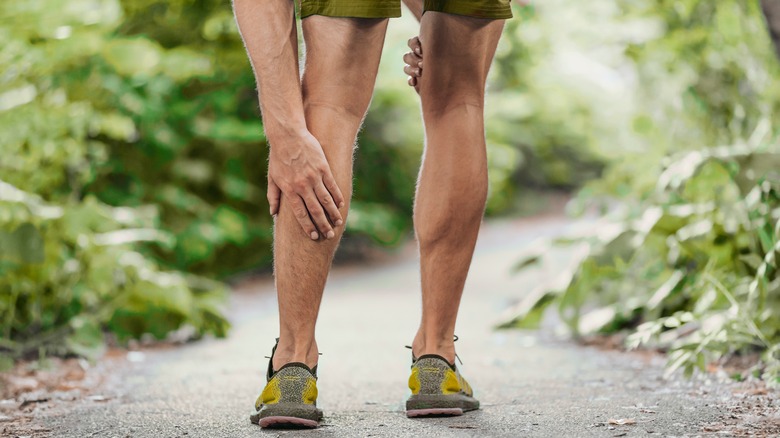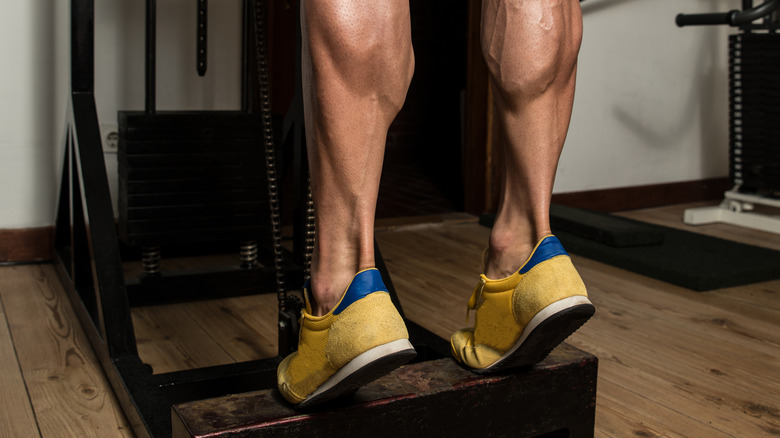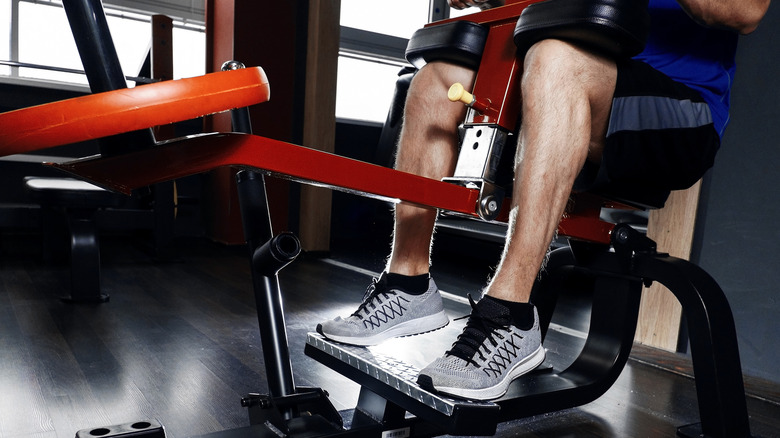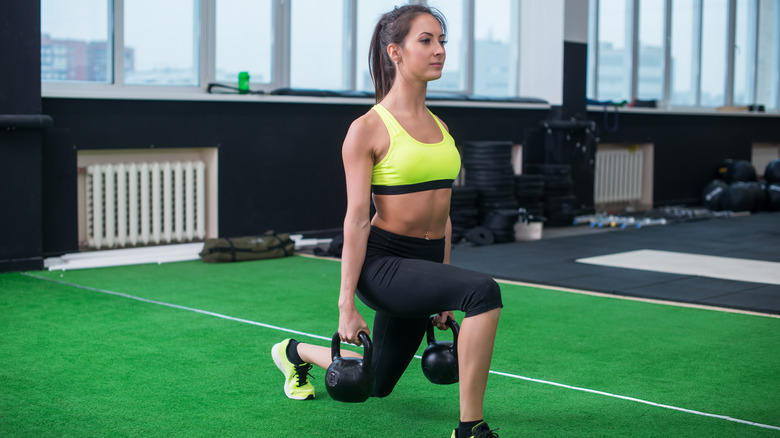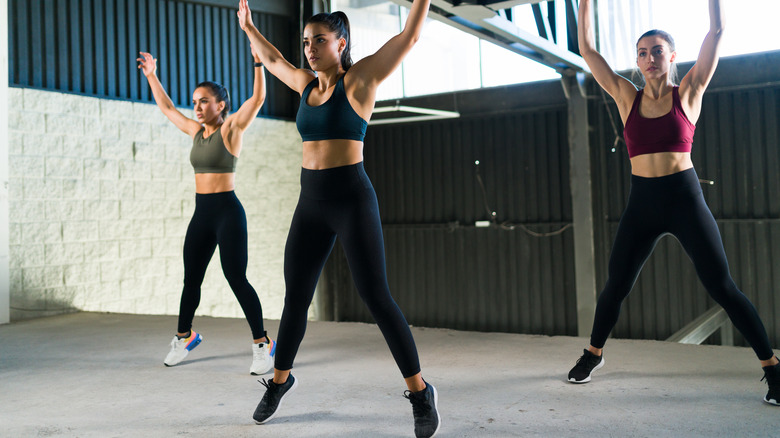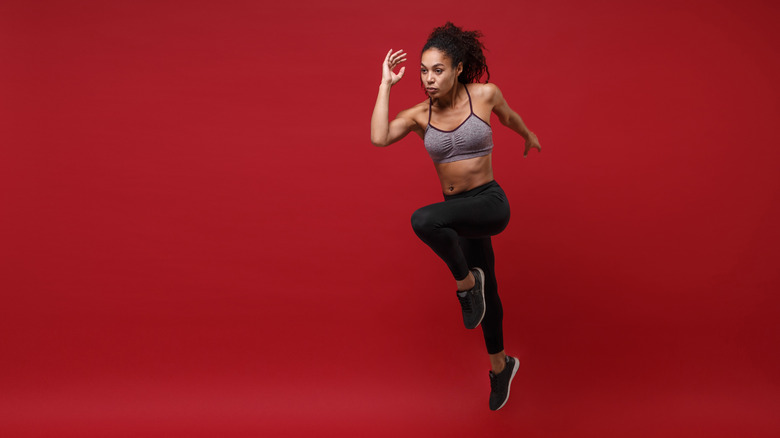The Best Exercises To Strengthen Weak Calves
Leg day can conjure groans for some people, and finishing off a hard leg workout with calf exercises could easily get tossed in favor of a post-workout protein shake. Strong calves can bring on envy from others as they see that nice cut as you walk past. According to Sport & Spinal Physiotherapy, building strength in your calves prevents plantar fasciitis, shin splints, knee pain, and tendinitis. If you're an athlete, strengthening your calves can help you run faster, jump higher, or perform longer.
Your calves have two main muscles that make up the calf complex. The gastrocnemius is the big muscle that forms that ball you see on the back of your lower leg. This muscle has fast-twitch fibers, meaning it's all about explosive power for jumping and sprinting. The soleus is underneath the gastrocnemius, and it's longer and thinner. It has more slow-twitch fibers that help with your endurance and posture.
Strengthening weak calves can be tough, but not impossible, according to Men's Journal. It just takes a few exercises to get the muscles firing.
Standing calf raises
A basic calf-strengthening exercise is the standing calf raise (via WebMD). What's great about this exercise is that you can do it anywhere and at any time. Start with both feet about hip-width apart with your ankles, knees, and hips all in one line. At first, place your hands on a wall or a chair to help with balance. Press into the balls of your feet as your heels raise off the floor. Drive straight up without leaning forward or backward. According to Sport & Spinal Physiotherapy, lift and lower slowly for 10 repetitions, and aim for three sets.
You can add intensity to this exercise by doing single-leg calf raises, holding weights, or performing them faster to add power. You can also vary this exercise by standing on a step or platform with your heels hovering off the edge. Keeping your knees bent at the same angle throughout the exercise can also provide a nice variation. As you get stronger, you can progress to three sets of 15 reps or four sets of 12.
Seated calf raises
Although you'll find a seated calf raise machine at the gym, you can also do this exercise at home, according to Sport & Spinal Physiotherapy. Sit on a chair and place a block or a book in front of you to anchor your toes. If you have weights at home, place them on your thighs. If not, WebMD suggests leaning forward with your hands on your thighs to give a little more resistance. Similar to standing calf raises, press the balls of your feet into the block and lift your heels. You should feel this action in the gastrocnemius and the soleus muscles. Lift for a count of two and lower for a count of four.
Adding a little variety to this exercise might mean turning the toes slightly in or out, according to Men's Journal. You can also up the intensity by doing one leg at a time or by increasing the speed of each repetition. Start with three sets of 10, then add more reps or sets as the exercise gets easier.
Farmer's walk
People who leave their 45-pound plates on the barbells at the gym are missing out on a great calf exercise–the farmer's carry (or farmer's walk). According to Swolverine, the farmer's walk is simply carrying two equal weights across the floor. This walk is controlled and will work your core, grip strength, and yes, your calves. Squat down and pick up the weight like you would a deadlift by keeping your chest up and core engaged. Walk about 20 to 50 feet taking small, deliberate steps. Be careful not to lean back and forth with each step. To be sure you're engaging your calves, try walking more on your toes (via Men's Journal).
If you don't have access to weights, you can try the tiptoe walk, according to Men's Journal. It's as simple as it sounds–walk around on your tiptoes without your heels touching the floor. To really activate your calves, try doing the tiptoe walk without shoes.
Jumping jacks and jump squats
You might think that jumping jacks are just for kids, but they're also great for working your calves, according to Men's Journal. If you need a refresher, stand tall with your arms at your sides. As you jump your legs apart, your arms reach overhead. A similar exercise is the seal jump, where your arms reach out like a "T" as you jump your legs apart. As you jump your legs back together, clap your hands in front of you.
Jump squats, or squat jacks, will help work your calves as well as get your heart racing, according to Swolverine. They will also build more power and speed. To do a jump squat, begin in a standard squat position with your weight in your heels. You'll roll your weight from your heels to the balls of your feet as you explode up and swing your arms back. As you land, be sure to land on your toes, then rock the weight back to your heels.
Hopping
If you think about it, running is simply doing several alternate leg hops for a distance, according to Sport & Spinal Physiotherapy. Hopping helps prepare your calves for explosive movements from the fast-twitch fibers in your gastrocnemius. You can hop on a single leg at a time in one spot, or you can hop along a square or diagonal path. To progress, try hopping faster or higher.
Why not use an agility ladder for hopping? According to Men's Journal, you can create a ladder on the floor using tape and hop up and down the ladder. Be sure to stay inside the lines. Sure, it might sound a little like adult hopscotch, but your calves will feel the burn.
Similar to hopping, you can also try lateral jumps (via Byrdie). This exercise will also work your abductors and adductors to power you from side to side. Squat down with feet hip-width apart, then lean to one leg as you lift the opposite. Using the power in your core and leg, hop laterally to the side and land on the opposite leg with your knee bent.

